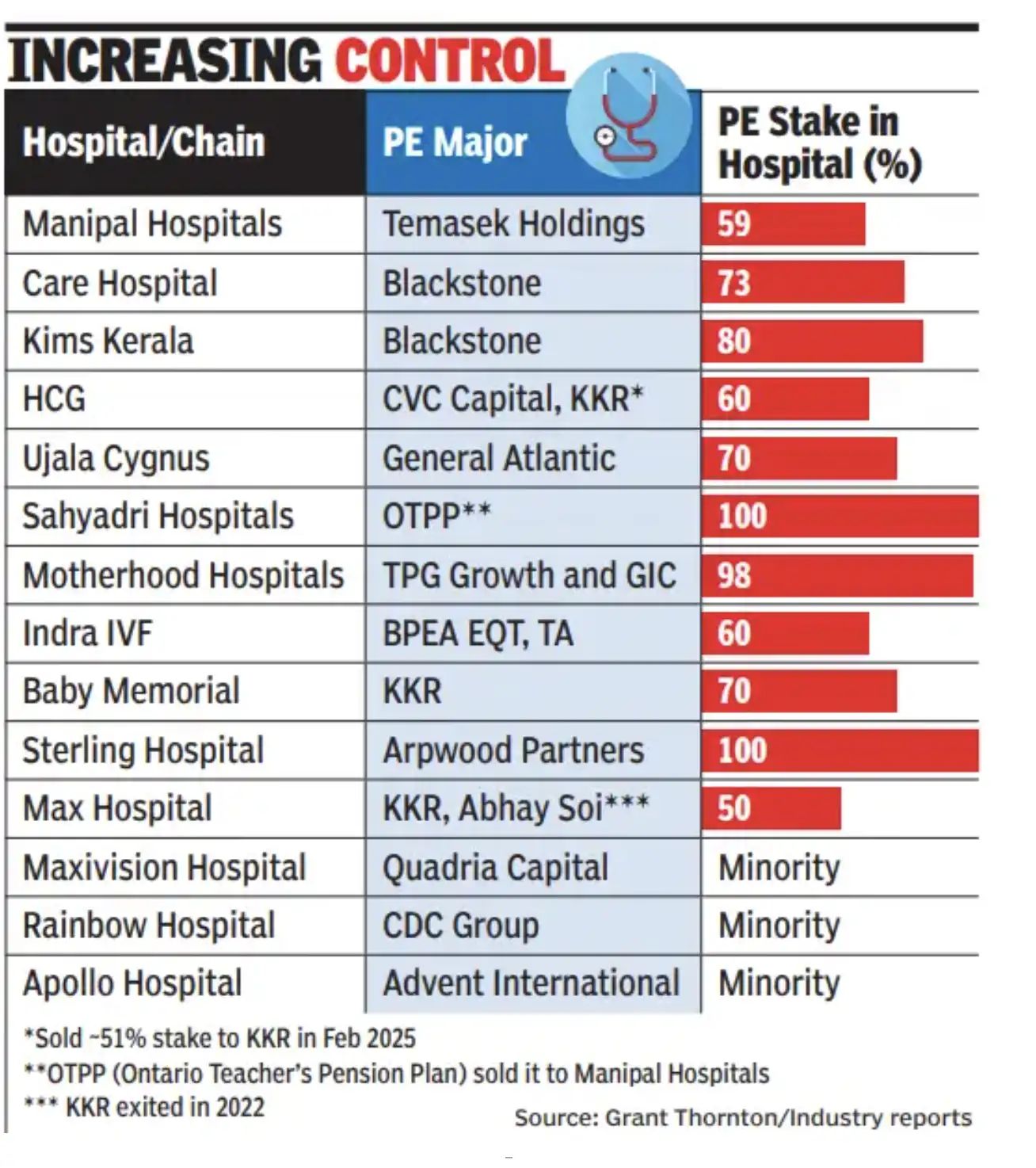- Finance by Tejas
- Posts
- Hospitals: The New Multibagger Factories of India
Hospitals: The New Multibagger Factories of India
From stethoscopes to stock returns – why the business of healing is now a booming investment story.

A curious paradox
If you’ve ever sat in a hospital waiting room, you know two things are certain:
There will always be patients.
You will always pay the bill (sometimes with a sigh, sometimes with gratitude).
Now, flip the lens for a moment. What if those bills — multiplied across thousands of beds, surgeries, and procedures — were actually compounding into handsome returns for investors?
That’s not fiction anymore. In the last five years, India’s hospital sector has quietly turned into one of the most profitable, scalable, and sought-after investment opportunities in the country.
The Great Ownership Shift
Until a decade ago, India’s hospitals were mostly “doctor-promoter” led — respected surgeons and physicians building institutions like Apollo, Narayana Hrudayalaya, or Fortis.
But since 2020, the ownership map has been redrawn. Private equity giants and sovereign wealth funds now dominate.
Since 2020, India’s healthcare attracted ~$15.5 billion in PE/VC, of which $9.2 billion went directly into hospitals.
Between 2022–2024 alone, hospitals accounted for 40% of all healthcare deal value (~$4.96 billion).
Recent mega-deals:
TPG pumped $2 billion into Manipal (which then acquired AMRI & Syadri).
KKR grabbed a 54% stake in cancer care chain HCG (~$400m).
EQT bet $656m on Indira IVF.
Blackstone & TPG merged Care + Evercare with Aster DM, doubling its bed count to 10,000+.
Why this sudden rush? Because India has one of the lowest hospital bed densities in the world (about 1.5 per 1,000 people vs WHO’s recommended 3.5). Combine that with rising lifestyle diseases, insurance penetration, and medical tourism — and you’ve got a near-permanent demand curve.

PE deals for Hospitals
Why Hospitals Work as Businesses
Hospitals don’t sell iPhones or shoes. They sell necessity. People don’t postpone a bypass surgery because the stock market is down. That’s what makes this business so robust.
Here’s what’s driving investor excitement:
Demand never dips: India adds 10,000+ new beds every year, with another 30,000 planned in the next five years.
Healthy margins: Despite heavy capex, leading hospital chains maintain 16–17% operating margins.
Medical tourism: India’s medical tourism tripled between 2020–2024 to $7.7 billion and is set to nearly double by 2030.
Tech adoption: 30% of complex surgeries in India now use robotics, boosting both outcomes and profits.
Put simply: hospitals combine social need + scalable economics — a rare combination in business.
The Multibagger Proof
If you had invested in Apollo Hospitals ten years ago, your money would have multiplied several times. With a market cap of ~₹1,07,000 crore, Apollo has been a poster child of how healthcare can reward investors.
Global investors have also booked blockbuster exits:
KKR’s ₹2,120 crore investment in Max Healthcare (2018) turned into ₹12,000 crore at exit.
Ontario Teachers’ Pension Plan sold Syadri at ~2.5× returns.
CBC exited HCG at 3.4× its entry price.
Even the new BSE Hospitals Index (tracking 15 listed hospital stocks) has delivered ~25% return in just one year — beating NIFTY and Sensex.
But Wait… the Risks
Before you get carried away, hospitals aren’t flawless money machines.
They’re capital intensive — land, equipment, staff training, compliance.
Regulation is tight. Pricing, licensing, and political pressure can alter margins overnight.
PE funds often chase 20–25% IRR in 5–7 years, which may push short-term profitability over long-term care.
Reputation risk is real — one scandal around billing or patient safety can dent years of goodwill.
This is why individual hospital stocks, while rewarding, can also be volatile.
Enter Healthcare Funds – Smarter Way to Play
Now here’s the sweet spot: instead of betting on one hospital stock (which carries all the risks), investors can own Healthcare Funds — curated portfolios that spread exposure across hospitals, diagnostics, pharma, medical devices, and global healthcare innovators.
Why healthcare funds stand out:
Diversification within healthcare: You’re not just riding Apollo or Max — you’re owning the broader healthcare growth story.
Global + domestic play: Many funds combine Indian hospitals with global leaders in biotech, pharma, and med-tech.
Lower volatility: One chain’s regulatory trouble gets offset by another’s growth surge.
Secular long-term trend: Healthcare demand is as inevitable as aging. India + the world will only spend more on health.
A Fun Perspective
In the stock market, fads come and go — electric cars, fintech, AI, crypto. But ask yourself: will India stop falling sick?
No.
If anything, lifestyle diseases, urban stress, and aging will ensure that hospital beds are never empty. And if those beds can be monetized smartly, healthcare funds give you a chance to sit on the winning side of that inevitability.
Closing Thought
Hospitals may heal patients, but they’re quietly enriching investors too. The sector is professionalizing, scaling, and delivering some of the most consistent compounding in India today.
So, the next time you pass by an Apollo, Fortis, or Max — don’t just see a building full of patients. See a multibagger in motion.
Because in the long run, wealth — like health — comes from steady care, not quick fixes. Let’s connect for such opportunities.
Warm regards,
Tejas